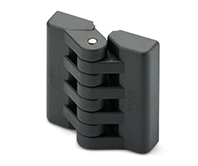Introduction:
Breather valves, also known as pressure/vacuum relief valves, are indispensable components in industrial settings, ensuring the safe and efficient operation of storage tanks. Proper installation and regular maintenance of breather valves are critical for their optimal performance and longevity. This article provides a comprehensive guide to best practices for the installation and maintenance of breather valve, emphasizing key considerations, and the role of stainless steel hinges (ss hinges) in enhancing reliability.
1.Installation Best Practices:
A. Strategic Valve Placement:
1. Consider Tank Design: Install breather valves at strategic locations, considering the tank’s design and intended functionality. Placement should facilitate efficient pressure relief while preventing the ingress of contaminants.
2. Avoid Obstructions: Ensure that the breather valve is not obstructed by nearby structures or equipment. Unimpeded airflow is crucial for proper valve operation during pressure relief events.
B. Proper Sealing and Gasketing:
1. Check Valve Seals: Verify the integrity of the valve seals and gaskets. Proper sealing is essential to prevent leaks and maintain the efficiency of the breather valve system.
2. Use High-Quality Gaskets: Employ high-quality gaskets compatible with the substances present in the tank. Stainless steel hinges (ss hinges) can enhance the durability of gasketed connections, contributing to overall reliability.
C. Consideration for Environmental Factors:
1. Corrosion Resistance: Choose materials, including stainless steel hinges, that offer corrosion resistance. This is particularly important in corrosive environments where exposure to chemicals may compromise the integrity of conventional materials.
2. Temperature Considerations: Take into account the temperature conditions in the operational environment. Ensure that the breather valve and its components, including ss hinges, can withstand variations in temperature without affecting performance.
2. Stainless Steel Hinges in Breather Valve Systems:
A. Corrosion Resistance:
1. Enhancing Longevity: Stainless steel hinges (ss hinges) play a crucial role in enhancing the longevity of breather valves. Their corrosion-resistant properties make them ideal for withstanding harsh industrial environments.
2. Compatibility with Substances: Stainless steel hinges maintain their structural integrity when exposed to various substances commonly found in industrial processes, contributing to the overall reliability of the breather valve system.
B. Material Compatibility:
1. Chemical Resistance: Stainless steel hinges are resistant to chemical reactions, ensuring that they remain durable and functional in the presence of different substances. This compatibility is vital for the overall performance of breather valves.
2. Reduced Maintenance: The use of stainless steel hinges reduces the need for frequent maintenance and replacements due to corrosion, contributing to cost savings and uninterrupted operation.
3. Maintenance Best Practices:
A. Regular Inspections:
1. Scheduled Checks: Implement a routine inspection schedule to assess the condition of breather valves. Regular checks help identify signs of wear, corrosion, or misalignment before they escalate into more significant issues.
2. Visual Inspections: Conduct visual inspections to ensure that all components, including ss hinges, are in good condition. Look for any visible signs of damage, such as rust, cracks, or deformation.
B. Lubrication of Moving Parts:
1. Apply Lubricants: Lubricate moving parts, including hinges, to ensure smooth operation. Regular lubrication prevents friction-related wear and tear, maintaining the efficiency of the breather valve.
2. Use Compatible Lubricants: Choose lubricants that are compatible with the materials used in the breather valve system. Consult manufacturer recommendations to avoid chemical reactions that may compromise performance.
C. Testing and Calibration:
1. Functional Testing: Conduct functional tests to ensure that the breather valve operates as intended. This may involve simulating pressure relief events to verify the valve’s responsiveness.
2. Calibration Checks: Periodically check and calibrate pressure settings to align with operational requirements. Accurate calibration is crucial for the breather valve to respond appropriately to varying pressure conditions.
D. Documentation and Record-Keeping:
1. Maintain Comprehensive Records: Keep detailed records of maintenance activities, inspections, and any replacements. Comprehensive documentation facilitates audits, compliance checks, and provides a historical overview of the breather valve system’s performance.
2. Include Material Specifications: Document the specifications of materials used in the breather valve system, including ss hinges. This information aids in future maintenance and ensures the use of compatible replacement parts.
4. Addressing Common Challenges:
A. Preventing Leakage:
1. Seal Integrity: Regularly inspect and replace seals and gaskets if signs of wear or damage are detected. Maintaining proper seal integrity is crucial for preventing leaks during pressure relief events.
2. Gasket Compatibility: Ensure that gaskets are compatible with the substances present in the tank. Choose gaskets made from materials that resist degradation in the presence of specific chemicals.
B. Minimizing Corrosion:
1. Corrosion-Resistant Coatings: Consider using breather valves with corrosion-resistant coatings or materials, including ss hinges. These coatings provide an additional layer of protection against corrosive elements.
2. Environmental Controls: Implement environmental controls, such as coatings or insulation, to shield breather valves from extreme weather conditions that may accelerate corrosion.
5.Future Trends in Breather Valve Maintenance:
A. Smart Monitoring Systems:
1. Real-time Data: Integration of smart monitoring systems for breather valves that provide real-time data on performance and conditions.
2. Predictive Maintenance: The use of predictive maintenance algorithms that analyze data to anticipate potential issues before they manifest, optimizing maintenance schedules and minimizing downtime.
B. Remote Diagnostics:
1. Remote Access: Remote diagnostics capabilities that allow maintenance professionals to assess the status of breather valves without physically being present.
2. Data-Driven Decision-Making: Leveraging data from remote diagnostics for informed decision-making, reducing response times to maintenance needs.
6. Conclusion: Ensuring Breather Valve Longevity and Reliability
In conclusion, the installation and maintenance of breather valves are fundamental aspects of ensuring the longevity and reliability of these critical components in industrial processes. Proper installation practices, the use of corrosion-resistant materials like stainless steel hinges, and diligent maintenance routines contribute to the overall efficiency and safety of storage tank operations.
As industries evolve, embracing future trends in breather valve technology, such as smart monitoring and remote diagnostics, will further enhance maintenance practices. By adhering to best practices and staying abreast of technological advancements, industries can ensure that breather valves continue to play a pivotal role in maintaining safe and efficient operations.



